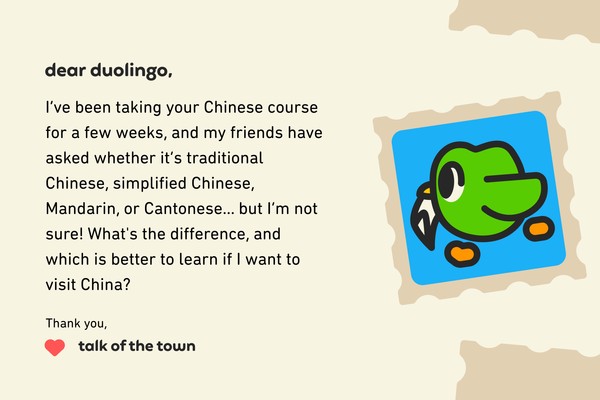Duolingo offers a popular and accessible platform for language learning, but can you effectively learn Mandarin Chinese using it? This article explores the nuances of the Chinese language, the specific type of Chinese taught on Duolingo, and whether it equips learners to navigate the linguistic landscape of China.
Mandarin vs. Cantonese: Which Does Duolingo Teach?
Duolingo provides courses in both Mandarin Chinese and Cantonese. However, the courses differ significantly in their target audience and writing systems. Duolingo’s Mandarin Chinese course, available to English, Japanese, and Vietnamese speakers, utilizes Simplified Chinese characters. Conversely, the Cantonese course caters to Mandarin speakers and employs Traditional Chinese characters.
Mandarin, also known as Standard Chinese or Putonghua, serves as the official language of mainland China. It’s rooted in the Beijing dialect and dominates education, government, and media. Due to its widespread use, Mandarin is often the first choice for Chinese language learners.
Cantonese, prevalent in Guangdong province, Hong Kong, and Macau, distinguishes itself from Mandarin through pronunciation, vocabulary, and even grammatical structures. A notable difference lies in the tonal system: Mandarin employs four tones, while Cantonese utilizes six.
Linguistic Diversity in China: Beyond Mandarin and Cantonese
While Mandarin is widely understood across China due to its prevalence in education, the country boasts a rich tapestry of regional dialects. Besides Mandarin and Cantonese, six other major Chinese language groups exist: Northern, Wu, Gan, Xiang, Min, and Hakka. These groups differ in pronunciation, grammar, and vocabulary, reflecting China’s cultural and historical diversity.
Mutual intelligibility between these dialects varies. While Mandarin speakers can readily understand Northern dialects, communication becomes more challenging with Southern dialects like Cantonese and Hakka.
Understanding Hanzi: The Chinese Writing System
Hanzi, the logographic writing system used for Chinese, transcends dialectal differences. Unlike alphabets where letters represent sounds, each Hanzi character embodies a word or a meaningful component of a word. This means pronunciation isn’t inherent in the character’s visual form but must be learned separately. Pinyin, a Romanization system, aids in representing pronunciation.
Many Hanzi characters incorporate radicals, graphical components that hint at the character’s general meaning. For instance, the radical 女 signifies “female” and appears in characters like 妈 (mā, mom) and 姐 (jiě, older sister).
Two forms of Hanzi exist: Simplified and Traditional characters. Simplified characters, adopted by mainland China, Singapore, and Malaysia, arose from literacy campaigns in the mid-20th century. Taiwan, Hong Kong, and Macau continue to use Traditional characters.
Can Duolingo Effectively Teach You Mandarin?
Duolingo’s Mandarin course with Simplified characters offers a solid foundation for beginners. It introduces vocabulary, grammar, pronunciation (using Pinyin), and basic sentence structure. However, mastering the complexities of Mandarin requires supplementing Duolingo with other resources. Consider incorporating immersive experiences like conversing with native speakers, consuming Chinese media, and exploring more comprehensive textbooks or language exchange programs.
Conclusion: Duolingo as a Starting Point for Mandarin Learning
While Duolingo might not single-handedly equip you for fluency, it serves as a valuable starting point for your Mandarin learning journey. By providing a structured curriculum and interactive exercises, Duolingo can build a foundational understanding of the language. Remember to leverage supplementary resources and immersive experiences to achieve true proficiency. So, Can You Learn Mandarin On Duolingo? Yes, to a degree, but remember that true mastery comes from a multifaceted approach.

